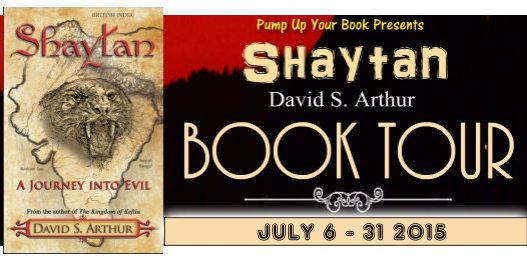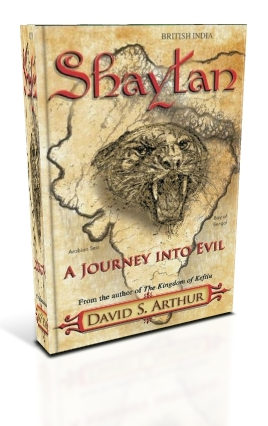Title: Shaytan: A Journey Into Evil
Author: David S. Arthur
Publisher: Brighton Publishing LLC
Pages: 395
Genre: Adventure/Thriller
My Review
Here’s the plot. The year is 1947. Richard and Emily Quizzenbury are on an expedition in India and accept an invitation to stay with their good friend, Victor Bloodworth, for a week before venturing on.
Upon their arrival in Bombay, they are greeted by a very excited Victor. It seems there is a man-eating leopard attacking Gohatti villagers in Timarni, located deep in the dense forests and mountains, and they’ve requested his help. He invites them to come along, figuring it will be a quick hunt and kill.
That’s how it sounded, but that’s not how it was.
I loved how this story was told. You’ll read this as journal entries from Richard, Emily, and Victor. They each wrote about what was happening and shared their thoughts. This made it very easy to understand their actions.
The research for this book must have been immense as the author delves into historical facts and religious beliefs for the different areas.
The characters do, as they say, wax philosophical, and each contributes their own knowledge and beliefs, leading to many late night discussions with a good nip of brandy or gin. They don’t always agree and I also enjoyed the subtle disdain when one didn’t agree with the other.
As for the man-eating leopard. He’s very much a part of the story. Victor scoffs at the villagers and their belief that it’s Shaytan, a man by day and a leopard by night. As the killer repeatedly slips through his traps and drags off more victims, he becomes more determined to kill the beast and show them it’s just an animal.
The leopard isn’t playing by the rules and continues to elude it’s death. The bodies pile up, villagers barricade themselves in their huts at night, and the beast huffs and puffs, trying to get in.
This is where the thrills and chills got me. That leopard was evil with four feet. It eluded every trap and slipped through every barricade. I was reminded of the movie, Ghost and the Darkness. The creature seemed to take on a mythical, supernatural ability, as it continued to steal lives.
A couple of scenes had my heart skipping and the tension was agonizing and exciting.
Another scene that gave me the willies was an encounter Victor had with a huge cobra. It’s safe to say, I wouldn’t have survived that encounter. Whether I died from it’s bite or from sheer terror.
So visually written I could feel the humidity, smell the rotting vegetation of the woods, and hear the leopard at the door, I was so thoroughly entertained that I went to bed late and got up early to finish this book.
Categorized as an adventure/thriller, if you don’t read this genre, I recommend you step out of your box and give it a go. A most excellent journey.
5 Stars
~~~~~~
India – 1947. In the heart of the jungle, death stalks the night. The authorities claim it is a man-eating leopard. The natives believe it is something far more terrifying—a creature that by day wears the skin of a man, but when craving human flesh becomes the demon…SHAYTAN! While on expedition to India, historical sleuth Richard Quizzenbury and his wife, Emily, suddenly find themselves on the hunt for a killer.
For his action-packed new thriller, SHAYTAN–A JOURNEY INTO EVIL, Santa Fe novelist David S. Arthur combines adventure, mysticism, and history to transport his readers into a world in which time marches to the pulse of the cosmos; where the spiritual and the supernatural merge and reality shares equal footing with illusion.
Fans of SHAYTAN–A JOURNEY INTO EVIL are already expressing excitement and fascination for the new book, among them Tom Wright, prominent American film and television director (NCIS, Supernatural, Castle). “Man you really get into it! The cobra scene scared the @#$% out of me. This is Spielberg on steroids.”
Seeking relief from the devastation of post-war Britain, Richard and Emily Quizzenbury embark on a tour of India. They plan to initially spend a week in Bombay with Richard’s old Oxford chum, Victor Bloodworth, after which they will satisfy their appetite for adventure by exploring historical sites throughout the Indian subcontinent.
On their first night in Bombay, Victor informs the Quizzenburys that he has been asked to undertake the hunt for a man-eating leopard that has been terrorizing the inhabitants in a remote
area of the Indian Central Provinces. Victor is the illegitimate son of a wealthy Englishman, now deceased, who was by trade a legendary big game hunter. While Victor has long since rejected his father’s brutal profession, he is himself a skilled hunter and reveals his intent to help the people who are being threatened by the leopard. Although the villagers of the region believe the man-eater is a demon that they call Shaytan, Victor is convinced the leopard is actually being forced to prey on humans due to injury or old age. He wants to capture the animal alive and relocate it to a zoo for scientific study.
Quite unexpectedly, Victor invites the Quizzenburys to accompany him on the hunt, explaining that his uncle and spiritual mentor, Ashok Kahn of the Forest Guard, will join them as an expert Shikari guide. The Quizzenburys reluctantly agree, hoping Victor will be able to capture the beast as quickly as he anticipates, so they can be free to pursue their travels. However, the hunt for the leopard soon escalates into a terrifying struggle for survival during which many innocent lives are lost, as the hunters – and the Quizzenburys – become the hunted.
“Shaytan is far more than just a jungle adventure,” Arthur insists. “It is about the ageless conflict between good and evil, the ruthless march of empires, the rise of the world’s great religions, the discovery of the New World, the laying of this century’s geo-political foundations, and the establishment of hostilities that are today’s headlines. And India was the epicenter of it all.”
According to Arthur, for Richard Quizzenbury – who is never without his books – the expedition becomes a quest for truth, which is his passion – the truth about history and religion and science – the truth behind our darkest nature as a species and our most primal fears and beliefs.
“For Victor it is far more personal,” Arthur explains. “Victor is half English, half Indian – with a Hindu background. He is haunted by the memory of his mother’s murder when he was a child, his father’s apathy toward him growing up, his bi-racial heritage and his uncertainty about his faith. His Uncle Ashok’s presence brings these conflicts to the fore.
Through their daily prayers and rituals invoking the ancient gods to guide and assist them, Victor’s search for personal redemption transcends the hunt; plunging him into the arcane realm of Vedic (Hindu) mysticism, in which the Hindu deities play a deciding hand in his life or death battle against the beast.”
As a writer, Arthur enjoys peeling back the layers of history, digging up the past, searching for answers to ancient riddles. “My intention is to entertain by taking my readers to exotic places they may never go and revealing things they might never know. In short, I write for the thrill of discovery, and I want my readers to share that experience.”
For More Information
- Shaytan: A Journey Into Evil is available at Amazon.
- Pick up your copy at Barnes & Noble.
- Discuss this book at PUYB Virtual Book Club at Goodreads.
Enjoy the Excerpt!
I am at present in hospital at Timarni Station in the Harda District of the Indian Central Provinces. I am recovering from certain unexplained maladies sustained during our hunting expedition to Gohatti Village and neighboring jungle environs. Although physically weakened, thankfully I have suffered no permanent damage. I am in sound condition and my mental faculties are now fully restored.
During the five weeks I pursued the Gohatti man-eater, six innocent victims met their fate in the jaws of this killer, including my own dear uncle, Ashok Kahn of the Central Provinces Forest Guard. There are those who may argue that my contest with this leopard was a battle between the forces of good and evil. Many have called this beast Shaytan, meaning demon. However, there is nothing to imply the Gohatti man-eater was anything other than a jungle beast doing its best to survive. Why it had developed a preference for human flesh, we shall probably never know.
The evening of my confrontation with the man-eater, I was seated motionless in the forest near a village called Nandwa, with my back against the base of a giant teakwood tree, waiting for the leopard. In front of me was a freshwater pool surrounded by a mature bamboo grove. Thorn barriers had been constructed around me, offering some scant protection. Above me in the tree on a machan, Richard Quizzenbury, my hunting companion, was guarding my back.
We sat patiently while the sun faded and the stars emerged one by one, glistening through the treetops. Algol the Demon Star was just appearing over the mountains and the moon was barely a crescent. Save for this and the light of the stars, we were soon surrounded by complete and utter darkness. My ears were to be my only defense. Should the man-eater come—and I had no doubt that it would come—its attack would be instant and unexpected—as would be my death if my attention flagged. While waiting and listening for the arrival of my adversary, I repeated a charm often recited by my uncle. From all that flies, from all that crawls, from all that prowls the mountain, oh night, protect us.
From all that crawls, indeed. From all that slithers.
I heard the great snake well before I felt its horrible weight against my leg. By the extent of its glide, I had a sense of its length; by the rustle of its passage, an appreciation for its girth. To my horror, I realized that the King of Cobras had come calling. All of my plans suddenly came undone. In my strategy to kill the leopard, I feared that my greatest vulnerability would be the loss of hearing due to wind or rain. Now the very unmistakable sound of the enormous reptile’s approach sent a shudder through every muscle in my body.
The cautious touch of its muzzle against my thigh brought a nearly overwhelming urge to recoil, but I knew the slightest twitch would bring certain and agonizing death. In each hand, I gripped the stock of a rifle. Under such circumstances, they were useless. Cobras hunt by sense of smell, and I had no doubt it could detect my scent; even more so, my fear. While I sat rigid with terror, it probed the space between my legs with its deadly snout, working methodically closer and closer to my groin, inching its heavy body back and forth across my legs with each sweep of its venomous head. I imagined its tongue lapping the air, sampling the sweet smell of its prey and perhaps wondering what manner of creature it had ensnared in its deadly strike zone. I was not something cold and scaled; not some smaller serpent, its habitual feast. I was something much larger and warmer, exuding a peculiar odor from every pore, saturating myself with an alien scent to which the terrible viper was unaccustomed.
At my waist, the cobra suddenly reared upright, its head rising well above me in the moonlight. The great hood was fanned as wide as my two hands. Sensing danger, it opened its mouth and hissed, emitting a foul stench past its lethal fangs. I clenched my eyes, anticipating the spray of its venom, enough to kill a man. But it did not spray, and I braced for the bite. But the bite did not come. I could hear its breathing close before me, slow and purposeful, calming like a mantra.
Breathing in and breathing out. Just like a mantra.
And our breathing became as one, the cobra and I. Breathing in together. Breathing out together. Together we invoked the rhythm that is the vibration of all living things, the perpetual mantra of existence, the breath of the cosmos—the supreme resonance of the Om.
And I concentrated on the Om in order to steel myself. Om, the absolute reality—without beginning without end. Adi Anadi. Embracing all that is. Beyond limit, undeniable, transcendental, indestructible, the wholeness of eternity, the echo of the Brahman.
I opened my eyes to find the terrible reptile looming over me, watching, breathing, swaying side to side, to and fro, hypnotically, its majestic hood expanding and contracting in perfect tempo with our breathing, no longer threatened, no longer threatening. Above its broad head hung the crescent moon, haloing its royal crown with an unearthly aura, casting its shadow full across me. And I prayed to the gods, an ancient charm.
Let not the serpent slay me, O Gods. Reverence be paid to the demon brood! I close together fangs with fang, I close together jaws with jaw. I close together tongue with tongue, I close together mouth with mouth.
Whether or not in answer to my invocation, slowly, imperceptibly, the viper leaned forward, and I prepared myself for the sting. But it did not sting. Rather to my absolute and indescribable horror, it wrapped itself slowly around my neck, not once but three times. Like the serpent on the shoulders of Lord Shiva, it came to rest with its weight full upon me. Its head was erect next to mine, just beside my cheek. I could hear it breathing, and I breathed with it.
Bound in those dreadful coils, I was gripped by the certainty of Samsara, of the soul traveling from one lifetime to the next. Like a man whose death has already come, I felt myself released from my physical bonds into a realm where heaven and earth, reality and nonreality, flowed without form or substance in a never-ending stream of unconscious awareness. Then I whispered the Shiva mantra, Maha Mrityunjaya, the call for deliverance.
O praise to the Three-Eyed One, who increases prosperity, who has a sweet fragrance, who frees the world from all disease and death—liberate me, as the cucumber is easily severed from the vine. O Shiva, grant me immortality!
And I thought of the amulet around my neck—not the bauble given me by a sadhu mystic, but the scaled one, Vasuki the lord of serpents, wound thereabout three times, breathing in my ear, poised to strike its deadly blow; and I heard the words for protection the sadhu had offered me.
Upon the strong is bound the strong, this magic cord, this amulet. This charm, foe-slayer, served by many heroes, strong, powerful, victorious, and mighty, goes bravely forth to meet and ruin witchcraft.
Again, I smelled the breath of the serpent king. I felt a sharp prick upon my cheek, and I sensed its departure from around my neck. And I watched in a daze, as my vision grew dim.
Then, in the void, two red eyes appeared, as red as flame, eyes like fire. And I heard the roaring of the beast, and I fired my guns.
This is what I remember of that night when I stared into the eyes of death. Of these things I can be certain—of these things only.
Maya’s web of illusions is still spinning.
~~~~
Author David S. Arthur
David S. Arthur is an American novelist with a taste for international adventure and ancient history. THE KINGDOM OF KEFTIU: A MYSTERY OF THE ANCIENT WORLD was David’s first book to feature English historical sleuth, Richard Quizzenbury and his feisty wife, Emily. It is an archaeological adventure set in the Greek islands. His new novel, SHAYTAN–A JOURNEY INTO EVIL, continues the Quizzenbury Adventure series. Before focusing on fiction writing, David enjoyed a long and rewarding career as a writer, producer, and director of hundreds of film and digital video presentations, theatrical performances, concerts, and large scale audience events. David currently lives in Santa Fe, New Mexico.
For More Information
- Visit David S. Arthur’s website.
- Connect with David on Facebook and Twitter.
- Find out more about David at Goodreads.
- Contact David.
~~~~~
Until the next time….
Thanks so much for visiting fuonlyknew!





















